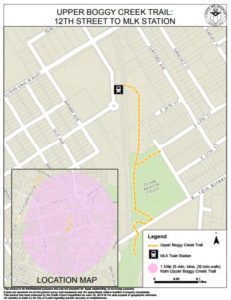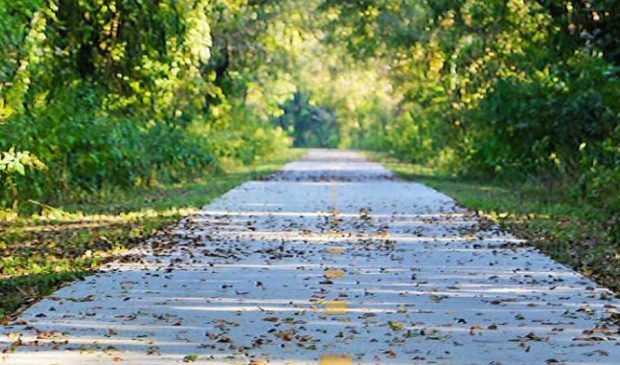Upper Boggy Creek Trail one step closer to reality
Tuesday, September 26, 2017 by
Jessi Devenyns After a contentious debate among the commissioners, the Environmental Commission approved a variance request submitted by the Public Works Department to widen the design of a concrete trail from 12 feet to 14 feet on Sept. 20 with only Vice Chair Peggy Maceo dissenting.
Currently, the Public Works Department and the Urban Trails Program are collaborating to construct a path through the heart of East Austin that will provide commuters a safe path and ease of access to two major public transport hubs as well as offer a protective, alternative route to pedestrians and cyclists between Martin Luther King Jr. Blvd and East 12th Street.
However, in order to accommodate both cyclists and pedestrians traveling in both directions, the Public Works Department is asking to vary the limit instated by the Urban Trails Master Plan that a hard surface trail in a Critical Water Quality Zone does not exceed 12 feet. Staff is asking for a 2-foot extension to 14 feet.
Development Services Department staff was unable to make a recommendation for approval because the Findings of Fact were not met. But, Environmental Officer Chuck Lesniak stepped up to address the commission and offer his support of the variance request on the condition that “if this is approved, the Public Works Department removes 19,520 square feet of asphalt and restore with native grassland seeding.”

The asphalt in question is a swath of impervious cover located at 2801 E. 12th St. Commission Chair Marisa Perales agreed that the land at this address should be recovered saying, “It needs to be cleaned up no matter what happens with this variance.”
The request to widen the proposed trail came to the commission for approval because according to Lesniak, “this is a little bit of an unusual case.” Generally, a request for a variance must be supported by regulatory requirements and not based solely on design. Although the presented variance request was driven by design, in this case, “Based on the experience and expertise of the Trails staff, this is going to be one of the main trunk trails going north to south,” explained Lesniak. “I think it’s a responsible design based on anticipated use.”
Community member Doug Boyer, too, came to offer the support of Friends of Boggy Creek saying, “Overall, we’re definitely in favor of the trail going through. We don’t have an opinion with the width of it.”
Janae Spence, the program manager for the Urban Trails Program, said that the original design called for a 20-foot-wide trail and that reducing the width down to 14 feet was already a compromise. The current plan also includes the trail narrowing to 11 feet when approaching the two terminal ends in order to preserve heritage trees.
In response to the suggested dimensions, Maceo asked about the width of the trail shoulder. Spence confirmed that there would be a permeable 2-foot shoulder on either side. “So basically you will have a trail 18 feet wide,” said Maceo.
Perales said that a data-driven justification for the variance request would “help me feel more comfortable” because “technically we’re not supposed to approve a variance if the Findings of Fact aren’t met.”
To understand the alternatives to the proposed change, the commissioners discussed different methods of incorporating a wider trail into the designated space with staff. Spence said that a 12-foot trail wouldn’t allow for dual direction cycling, so to ensure separation of cyclists and pedestrians, if this variance request was not approved, the Trails Foundation could build a 10-foot trail next to a 6-foot one, making the overall environmental footprint greater. Alternatively, they could apply at a later date to extend the width of the trail, though Spence explained that would cost more.
Commissioner Andrew Creel looked at the project from a different perspective saying, “Equivalently what they are removing (with the approval conditions proposed by Lesniak) and what they are adding comes in less than the amount of the impervious cover that code allows.”
Spence responded generally to the concerns presented by the commission saying, “there have been multiple meetings over multiple years, and most people were in favor of the project.”
Commissioners took a break to draft a motion to approve the construction of the trail with several caveats so as to not set a precedent with their consent before voting to approve the variance. Construction on the trail is expected to start before the end of the year.
Photo and map courtesy of the city of Austin.
The Austin Monitor’s work is made possible by donations from the community. Though our reporting covers donors from time to time, we are careful to keep business and editorial efforts separate while maintaining transparency. A complete list of donors is available here, and our code of ethics is explained here.
You're a community leader
And we’re honored you look to us for serious, in-depth news. You know a strong community needs local and dedicated watchdog reporting. We’re here for you and that won’t change. Now will you take the powerful next step and support our nonprofit news organization?










